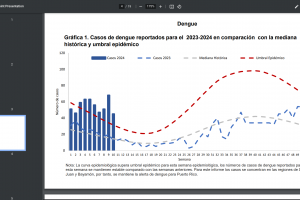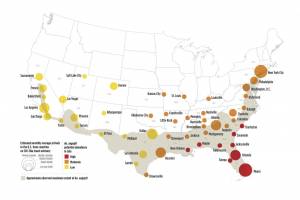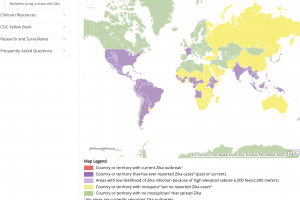Zika Outbreaks
Zika Outbreaks 2024
Zika virus (ZIKV) is transmitted to people by mosquitoes of the genus Aedes, according to the World Health Organization (WHO). Zika virus disease cases have been noted since 2007. Since an outbreak in Brazil in March 2015, and as of 2024, the Pan American Health Organization (PAHO) has confirmed local transmission of Zika in countries and territories in the Region of the Americas. Ten countries account for about 89% of Zika cases recorded between 2014 and 2023.
As of March 2024, the PAHO reported over 1,100 ZIka cases in the Americas this year. The United States (U.S.), WHO, U.K., and Canada list countries where ZIKV infections are known to occur.
Zika Virus Reinfections
The U.S. Centers for Disease Control and Prevention (CDC) published Research, Volume 30, Number 2—February 2024. Temporal phylogenetic analysis revealed limited within-host diversity among most ZIKV-persistent infected associated samples. However, we detected unusual virus temporal diversity from >5 persons, uncovering the existence of divergent genomes within the same patient.
Zika Outbreaks The Americas 2024
In February 2024, the PAHO reported Brazil (867), Columbia (50), Bolivia (27), Peru (6), Costa Rica (6), and Puerto Rico (3) had reported Zika virus cases in 2024.
Zika Outbreaks The Americas 2023
The PAHO reported 36,738 Zika cases in the Americas as of December 31, 2023, with the highest proportion of Zika cases reported in Brazil (35,041), Bolivia, Belize, Columbia, Paraguay, and Venezuela. The PAHO reported in December 2023 that Belize (281), Guatemala (112), El Salvador (89), Puerto Rico (46), and Mexico (28) confirmed Zika cases in 2023. Costa Rica's Ministry of Health confirmed that in 2023, there have been about 27 Zika cases. In 2022, there were 45 Zika cases reported in Costa Rica.
Zika in Africa
In West Africa, ZIKV was first isolated from Ae. luteocephalus collected in 1968 in Senegal. The Republic of Mali general directorate of Health and public Hygiene confirmed 12 cases of Zika virus in the north-western African country, with the first three cases confirmed on December 1, 2023. The first Zika case in Guinea was reported in July 2023.
Zika in Asia
On January 4, 2024, local media reported 25 cases of Zika virus in Hua Hin, Thailand. From January 2023 to December, 722 Zika virus cases were reported in Thailand. Cases have been reported across 36 provinces, with the Central and Northern regions most affected.
Since 2016, the Zika virus has been reported in India's 16 different states/union territories. In November 2023, the Zika virus was found in mosquitoes in Talakayalabetta village in Sidlaghatta taluk, India, and one woman was infected in Pune. A 5-year-old girl has been infected with ZKV in Karnataka (Raichur district). The journal Frontiers in Microbiology published original research in June 2022 indicating that the Zika virus had spread to several states in India and that there was an urgent need to strengthen surveillance.
The Kingdom of Cambodia's Ministry of Health confirmed in September 2023 its first case of the Zika virus since 2016. Additional countries located in Asia have reported Zika cases in 2023.
Zika in Europe
In 2022, the European CDC reported that 31,453 Zika patients were confirmed in 13 of 52 countries and territories. In Europe, two imported Zika virus infections were confirmed by the Hungary National Reference Laboratory of Viral Zoonoses of the National Center for Public Health on February 27, 2023. The two infected persons had previously been to Thailand. In addition, the WHO reported in 2019 that French authorities confirmed an autochthonous Zika virus case in Hyeres, Var department.
Zika in India
According to the Times of India, government officials reported Zika cases in November 2023. The affected states are Maharashtra, Kerala, and Karnataka. The Zika virus was identified in mosquitoes in Chickballapur in early November 2023.
Zika Pacific Islands
As of October 2023, the Solomon Islands reported 7 Zika cases in 2023.
Zika South America
As of December 2023, the PAHO dashboard indicates that over 30,132 Zika cases have been reported in Brazil this year. In 2022, about 34,000 Zika cases and four deaths were reported, a 92% increase compared to the same period in 2021. There have been no related fatalities from Zika in 2022. First reported in Brazil in 2015, Zika was likely introduced to the country two years prior. A large Zika outbreak occurred in 2016, and about 215,000 probable cases were reported.
Although the Northeast (Rio Grande do Norte) and Southeast regions were likely to continue to have the highest total infection numbers, consistency-weighted, population-standardized rates highlighted hotspot states within all five regions in Brazil, reported the CDC.
Studies conducted in the states of Rio de Janeiro and São Paulo also indicated that temperature influenced the distribution patterns of Ae. aegypti and Ae. albopictus, controlling disease transmission. There are slight differences (from 0.7 to 2.6 ∘C) in the average temperature between the high-risk and no-risk areas for Zika infections. Banu et al. showed that an increase of 1 ∘C could be related to a future rise in arbovirus cases.
Furthermore, according to Brazilian authorities, more than 1,638 babies have been born with microcephaly-related defects since 2014. The Arbovirus Surveillance Strengthening Project launched in Brazil in 2022. From 2015 to 2020, 3,591 cases of CZS were confirmed in Brazil, with an incidence of 44.03 cases per 1,000 live births and a specific mortality of 12.35 deaths per 1,000 live births.
U.K. health authorities have classified Paraguay as having a risk of Zika virus transmission in 2023. In 2022, about 785 Zika cases were reported.
Zika Thailand
Thailand reported 742 Zika virus infections in 2023, with 160 recorded in the city of Bangkok. This is a significant increase from 190 Zika cases reported in 2022.
Zika United States
The U.S. Centers for Disease Control and Prevention (CDC) says that the mosquitoes that spread Zika are found throughout Puerto Rico. People living on the island who have already been infected are at risk for severe infection. In addition, the Puerto Rico Department of Health says Zika will continue to infect people in 2023. Puerto Rico's Weekly Report Arboviral Diseases #44 shows 43 probable Zika cases as of 2023 and 20 cases during 2022. In 2021, the CDC confirmed (2) Zika travel-associated and (32) local cases in U.S. territories. In 2020, only 4 Zika virus cases were reported in U.S. international travelers.
Zika United Kingdom
the U.K. Health Security Agency (UKHSA) issued a warning on March 21, 2024, concerning diseases such as Zika. In 2023, eight Zika cases were reported in England, similar to 2022. Zika cases in the U.K. peaked in 2016 with 725 cases.
Zika Virus Transmission
Zika is primarily spread by the bite of a mosquito infected with the virus, but it can also be passed during sex from a person infected with Zika to a sexual partner, says the CDC. About 25% of infected people may develop Zika symptoms, and the illness is usually mild, lasting between two and seven days, according to the CDC. Congenital Zika-associated syndrome (CZS) is a set of congenital anomalies seen in infants born to mothers with a history of gestational Zika fever, who have microcephaly as the most prevalent clinical sign. According to an April 2023 study, although microcephaly is the most severe manifestation observed in 1.5% of children at birth, severe microcephaly is less frequent. Furthermore, even though some children are born with an average head circumference, they may develop postnatal microcephaly.
Zika Virus Guillain–Barré Syndrome
In November 2013, a report on a French Polynesian patient presenting a Zika virus infection complicated by Guillain–Barré syndrome (GBS). Since the beginning of the Zika epidemic in 2016, the incidence of GBS has been multiplied by 20 in French Polynesia, raising the assumption of a potential implication of ZIKA.
Zika Virus History
The Zika virus was first isolated in 1947 in the Zika forest in Uganda (Africa). Since then, Zika has caused small, sporadic outbreaks in Africa, Asia, and South America. In 2007, a large epidemic was described on the Island of Yap (Micronesia), where about 75% of the population was infected. In 2014, Chile notified the WHO of indigenous transmission of Zika virus fever on Easter Island. Then, in May 2015, public health authorities in Brazil confirmed the transmission of the Zika virus.
Zika Vaccines
As of March 2024, there are no approved Zika vaccines.





